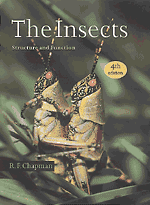Book contents
- Frontmatter
- Contents
- Preface
- Acknowledgments
- PART I The Head, Ingestion, Utilization and Distribution of Food
- PART II The Thorax and Locomotion
- PART III The Abdomen, Reproduction and Development
- PART IV The Integument, Gas Exchange and Homeostasis
- 16 Integument
- 17 Gaseous exchange
- 18 Excretion and salt and water regulation
- 19 Thermal relations
- PART V Communication
- Taxonomic index
- Subject index
16 - Integument
Published online by Cambridge University Press: 05 June 2012
- Frontmatter
- Contents
- Preface
- Acknowledgments
- PART I The Head, Ingestion, Utilization and Distribution of Food
- PART II The Thorax and Locomotion
- PART III The Abdomen, Reproduction and Development
- PART IV The Integument, Gas Exchange and Homeostasis
- 16 Integument
- 17 Gaseous exchange
- 18 Excretion and salt and water regulation
- 19 Thermal relations
- PART V Communication
- Taxonomic index
- Subject index
Summary
The integument is the outer layer of the insect, comprising the epidermis and the cuticle. The cuticle is a characteristic feature of arthropods and is, to a large extent, responsible for the success of insects as terrestrial animals.
EPIDERMIS
Epidermal cells
The epidermis is the outer cell layer of the insect. It is one cell thick with cell densities ranging from about 3000 mm−2 in a trachea of Rhodnius to 11000 mm−2 in the sternal area of larval Tenebrio, but cell density and cell depth at right angles to the surface of the epidermis change during development (see below).
The apical plasma membrane of an epidermal cell forms a series of short projections or ridges, flattened at the tips where the membrane is electron-dense on the inside (Figs. 16.1a, 16.18). These specialized regions of membrane are known as plasma membrane plaques and they are the sites of secretion of the outer epicuticle and of chitin fibers. During and just after a molt, the epidermal cells also have cytoplasmic processes on the outside extending into the pore canals of the cuticle (see Fig. 16.2), but these processes may be withdrawn as the cuticle matures.
The epidermal cells are held together near their apices by zonulae adhaerens and lower down by septate junctions (Fig. 16.1a). At greater distances from the cuticle, adjacent cells are not tightly bound to each other, and the spaces between them (lateral lymph spaces) are, to some extent, isolated from the hemolymph by desmosomes close to the basal lamina (Locke, 1991).
Information
- Type
- Chapter
- Information
- The InsectsStructure and Function, pp. 415 - 440Publisher: Cambridge University PressPrint publication year: 1998
Accessibility standard: Unknown
Why this information is here
This section outlines the accessibility features of this content - including support for screen readers, full keyboard navigation and high-contrast display options. This may not be relevant for you.Accessibility Information
- 4
- Cited by
